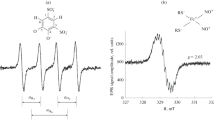Abstract
Formation of superoxide radical in isolated rat heart mitochondria under controlled oxygenation has been studied by spin trapping and EPR oxymetry. Lithium phthalocyanine and perdeuterated Tempone-D-15 N 16 were used to determine the oxygen concentration. Tiron was used as a spin trap. By varying the oxygen content in the reaction medium, we have shown that isolated heart mitochondria can produce superoxide even at an oxygen partial pressure of 17.5 mmHg, though at a rate considerably lower than under normal conditions. Raising the oxygen concentration increases the rate of superoxide generation.
Similar content being viewed by others
Abbreviations
- LiPc:
-
lithium phthalocyanine
- ROS:
-
reactive oxygen species
- Tempone-d16-15N:
-
4-oxo-2,2,6,6-tetramethylpiperidine-d16-15N-oxyl
- Tiron:
-
4,5-dihydroxybenzene-1,3-disulfonate (sodium salt).
References
E. Cadenas and K. J. A. Davies, Free Radic. Biol. Med. 29, 222 (2000).
C. Li and R. M. Jackson, Am. J. Physiol. 282, C227 (2002).
R. Ferrari, G. Guardigli, D. Mele, et al., Curr. Pharm. Des. 10, 1699 (2004).
G. Solani and D. A. Harris, Biochem. J. 390, 377 (2005).
S. Orrenius, V. Gogvadze, and V. Zhivotovsky, Annu. Rev. Pharmacol. Toxicol. 47, 143 (2007).
A. Carpi, R. Menabo, N. Kaludercic, et al., Biochim. Biophys. Acta 1787, 774 (2009).
M. Ksenzenko, A. A. Konstantinov, G. B. Khomutov, et al., FEBS Lett. 155, 19 (1983).
A. A. Ledenev, E. Ya. Popova, A. A. Konstantinov, and E. K. Ruuge, Biofizika 30, 1204 (1985).
J. St-Pierre, J. A. Buckingam, S. J. Roebuck, and M. D. Brand, J. Biol. Chem. 277, 44784 (2002).
J. F. Turrens, J. Physiol. 552, 335 (2003).
A. J. Lambert and M. D. Brand, J. Biol. Chem. 279, 39414 (2004).
M. P. Murphy, Biochem. J. 417, 1 (2009).
Q. Chen, E. J. Vasquez, S. Moghaddas, et al., J. Biol. Chem. 278, 36027 (2003).
F. L. Muller, Y. Liu, and H. van Remmen, J. Biol. Chem. 279, 49064 (2004).
W. Droge, Physiol. Rev. 82, 47 (2002).
F. J. Giordano, J. Clin. Invest. 115, 500 (2005).
T. Klimova and N. S. Chandel, Cell Death Differentiation 15, 660 (2008).
R. V. Shoet and J. A. Garcia, J. Mol. Med. 85, 1309 (2007).
G. L. Semenza, Genes. Dev. 14, 1983 (2000).
N. S. Chandel, D. S. McClintock, S. E. Feliciano, et al., J. Biol. Chem. 275, 25130 (2000).
A. N. Ledenev, A. A. Konstantinov, E. Y. Popova, and E. K. Ruuge, Biochem. Int. 13, 391 (1986).
P. E. James, O. Y. Grinberg, and H. M. Swartz, J. Leukocyte Biol. 64, 78 (1998).
F. McArdle, D. M. Pattwell, A. Vasilaki, et al., Free Radic. Biol. Med. 39, 651 (2005).
J. Ketonen and E. Mervaala, Heart Vessels. 23, 420 (2008).
Y. H. Han and W. H. Park, Oncol. Rep. 21, 253 (2009).
O. V. Korkina and E. K. Ruuge, Biofizika 45, 695 (2000).
I. V. Sviryaeva and E. K. Ruuge, Biofizika 51, 478 (2006).
H. Hou, O. Y. Grinberg, S. Taie, et al., Anest. Analg. 96, 1467 (2003).
H. M. Swartz, Antioxid. Redox. Signal. 6, 677 (2004).
Author information
Authors and Affiliations
Corresponding author
Additional information
Original Russian Text © I.V. Sviryaeva, A.S. Mertsalova, E.K. Ruuge, 2010, published in Biofizika, 2010, Vol. 55, No. 2, pp. 271–276.
Rights and permissions
About this article
Cite this article
Sviryaeva, I.V., Mertsalova, A.S. & Ruuge, E.K. Formation of superoxide radicals in isolated cardiac mitochondria: Effect of low oxygen concentration. BIOPHYSICS 55, 230–233 (2010). https://doi.org/10.1134/S0006350910020119
Received:
Published:
Issue Date:
DOI: https://doi.org/10.1134/S0006350910020119




